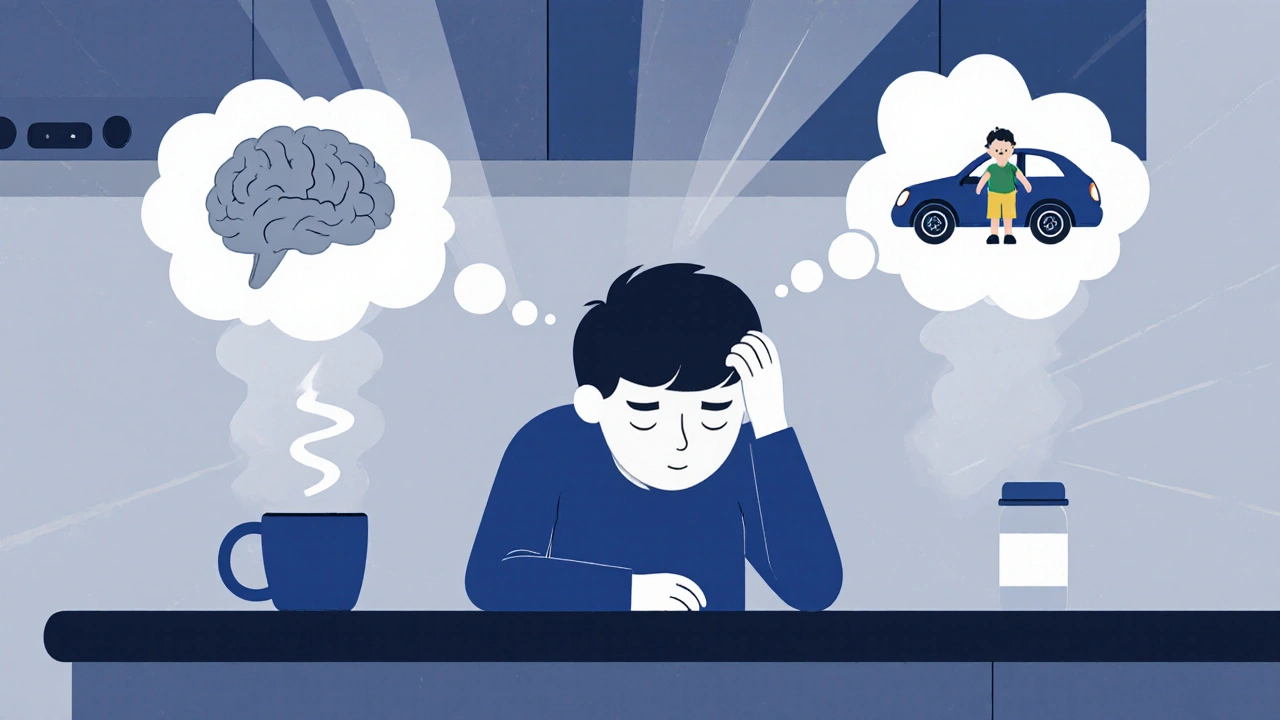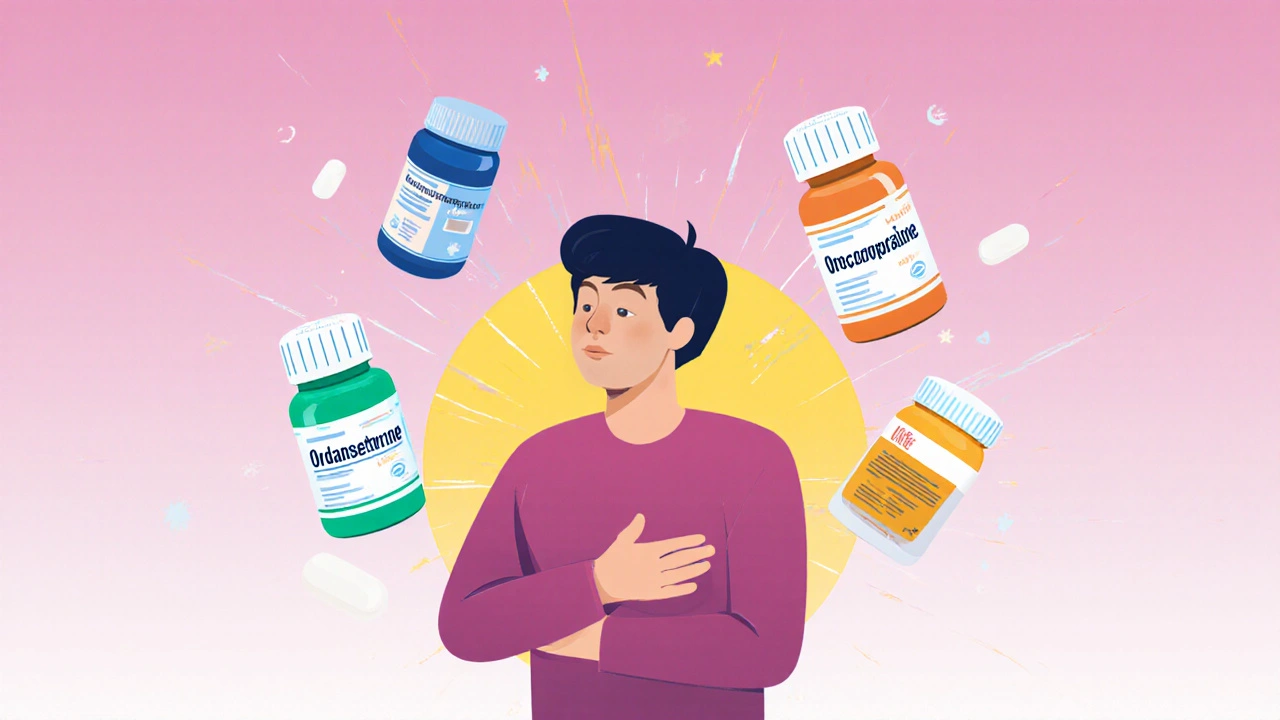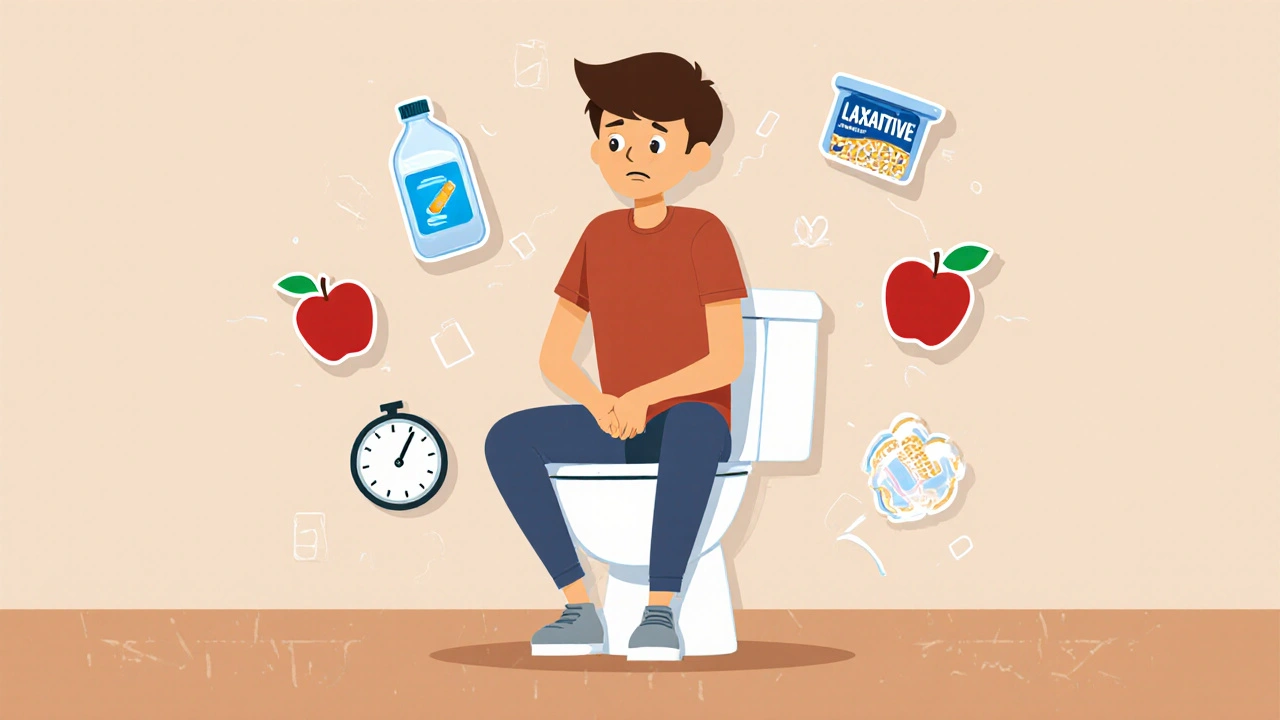Opioid Side Effect Management Checker
Your Side Effect Management
Check if you're following clinical guidelines for managing common opioid side effects. Answer all questions to receive personalized recommendations.
Constipation
Drowsiness
Nausea
When opioids are prescribed for severe pain-after surgery, for cancer, or following a major injury-they work. But they also come with side effects that can make life harder, not easier. Constipation, drowsiness, and nausea are the most common, and they don’t go away on their own. Unlike a headache or a sore muscle, these don’t fade after a few days. They stick around as long as you’re on the medication. And if they’re not managed, they can lead to stopping treatment, worsening pain, or even dangerous misuse.
Constipation: The One Side Effect That Never Fades
If you’re taking opioids long-term, constipation isn’t a possibility-it’s a guarantee. Nearly every patient experiences it. That’s because opioids slow down your gut. They bind to receptors in your intestines, making muscles contract less, fluids get absorbed faster, and stool moves slower. It’s not about diet or laziness. It’s pharmacology. The American Academy of Family Physicians says this is the most common side effect of chronic opioid use. And unlike drowsiness or nausea, which often improve over time, constipation doesn’t. It gets worse if you ignore it. That’s why doctors should start you on laxatives the same day you start opioids-not when you’re already struggling to go. First-line treatment? A combo of a stimulant laxative like senna and an osmotic agent like polyethylene glycol. These work together: one wakes up the gut, the other pulls water into the stool. If that doesn’t cut it, there are targeted options like methylnaltrexone (Relistor) or naloxegol (Movantik). These drugs block opioid effects in the gut but don’t touch pain relief in the brain. That’s the sweet spot: relief without losing pain control. Skipping laxatives because you think you’ll "just deal with it" is a mistake. Severe constipation can lead to bowel obstruction, hospitalization, or even surgery. Don’t wait. Start prevention early.Drowsiness: More Than Just Feeling Tired
Drowsiness hits 20% to 60% of people when they first start opioids. It’s not just feeling sleepy. It’s mental fog. Slowed thinking. Trouble focusing. Some people describe it like being underwater-everything feels distant. This happens because opioids depress the central nervous system. The brain’s alertness centers slow down. For most, this improves within a week or two as the body adjusts. But for 10% to 15% of long-term users, the fog never lifts. And that’s a problem. It affects driving, work, caring for kids, even simple tasks like cooking. The fix isn’t always more caffeine. It’s smarter dosing. Taking the opioid at night instead of in the morning can help. Lowering the dose slightly might be enough. Some patients benefit from switching to a different opioid-some cause less sedation than others. There’s talk about using stimulants like methylphenidate (Ritalin) to fight opioid-induced drowsiness. But the evidence is thin. These drugs come with their own risks: increased heart rate, anxiety, insomnia. They’re not a quick fix. The best approach? Talk to your doctor. Don’t push through the fog. If you’re nodding off during the day, your dose may be too high. And never mix opioids with alcohol, benzodiazepines like Xanax or Valium, or sleep aids. That combo can shut down your breathing. It’s the leading cause of fatal overdose.Nausea: Why Your Stomach Feels Like It’s Revolting
About one in four people feel nauseous when they start opioids. It’s not just queasiness. It’s vomiting, dizziness, and a constant urge to gag. This happens because opioids trigger the brain’s vomiting center-the chemoreceptor trigger zone-and slow down stomach emptying. The good news? For most, nausea fades after 3 to 7 days. Your body builds tolerance. But for 10% of long-term users, it doesn’t. And that’s enough to make someone quit their medication, even if they’re still in pain. Treatment depends on what’s causing it. If it’s brain-driven, dopamine blockers like metoclopramide or prochlorperazine work best. If it’s gut-related, anti-nausea meds like ondansetron (Zofran) help. Antihistamines like promethazine can also do the job, but they add more drowsiness. Don’t just take one antiemetic and give up. Try different ones. Some people need to rotate options. And if nausea hits hard after a dose increase, hold off on the next dose and talk to your doctor. A slower ramp-up often prevents it. Also, don’t stop opioids suddenly. That can cause withdrawal-and nausea is one of the worst parts. Withdrawal symptoms include vomiting, diarrhea, sweating, and muscle aches. The FDA warns that sudden discontinuation can lead to uncontrolled pain, panic, and even suicide. If you need to stop, do it slowly, under medical supervision.
Why Managing These Side Effects Matters More Than You Think
These three side effects aren’t just annoying. They’re gatekeepers to safe, effective pain control. When constipation is ignored, people stop taking their pain meds. When drowsiness makes them unsafe to drive or work, they feel trapped. When nausea makes them sick to their stomach every day, they lose hope. And when they stop taking their meds, their pain comes back-and they might turn to illegal drugs to fill the gap. The CDC reports that over 8 million Americans misused prescription opioids in 2023. More than two-thirds said they did it to relieve physical pain. That’s not addiction-it’s desperation. They weren’t seeking a high. They were trying to get through the day. Proactive management changes that. Starting laxatives on day one. Adjusting doses before drowsiness becomes dangerous. Trying different anti-nausea drugs before giving up. These aren’t afterthoughts. They’re essential parts of treatment. Doctors who treat pain well know this. They don’t just write a script. They follow up. They ask: "Are you going to the bathroom?" "Are you able to stay awake during the day?" "Do you feel like throwing up?" If your doctor doesn’t ask, ask them. You deserve to manage your pain without being crippled by side effects.What You Can Do Today
- If you’re starting opioids: Ask for a laxative prescription right away. Don’t wait until you’re backed up.
- Take your opioid at the same time every day. Consistency helps your body adapt.
- Drink plenty of water. Eat fiber-rich foods. Stay active-even light walking helps your gut.
- Don’t drive or operate heavy machinery until you know how the opioid affects you.
- Keep a symptom journal. Note when nausea hits, how drowsy you feel, and how often you go to the bathroom. Bring it to your next appointment.
- If you’re thinking of stopping because of side effects: Talk to your doctor first. There are solutions.

When to Call Your Doctor
Call immediately if you experience:- Not having a bowel movement for 3+ days despite laxatives
- Extreme drowsiness-you can’t stay awake even after a nap
- Vomiting that lasts more than 24 hours
- Confusion, slurred speech, or slow breathing
Do opioid side effects go away on their own?
Some do, some don’t. Drowsiness and nausea often improve within a week or two as your body adjusts. But constipation almost never goes away on its own. It requires active management with laxatives or specialized medications. Don’t assume side effects will fade-plan for them from day one.
Can I just stop taking opioids if the side effects are too bad?
No. Stopping suddenly can cause severe withdrawal symptoms like nausea, vomiting, diarrhea, anxiety, and intense pain. It can also lead to relapse or turning to unsafe sources of opioids. Always work with your doctor to taper off slowly. They can help you switch to a different pain treatment or adjust your dose safely.
Are there opioids that don’t cause constipation or drowsiness?
All opioids cause these side effects to some degree. But some, like tramadol or buprenorphine, tend to cause less sedation and constipation than others like oxycodone or morphine. Your doctor can try switching your medication to find one with a better side effect profile. There’s no opioid without risks, but there are options with fewer problems.
Is it safe to use over-the-counter laxatives long-term with opioids?
Yes, if used correctly. Stimulant laxatives like senna and osmotic agents like polyethylene glycol are safe for long-term use under medical supervision. Avoid daily use of stimulants alone-combine them with osmotic agents to reduce dependency. Never use enemas or suppositories regularly unless directed by a doctor. Your goal is regular, soft bowel movements-not dependence on harsh methods.
Why do some people get nausea from opioids but others don’t?
It varies by genetics, metabolism, and sensitivity. Some people’s brains react more strongly to opioids in the vomiting center. Others have slower stomach emptying. Age, prior nausea history, and other medications can also play a role. It’s not about being weak or overly sensitive-it’s biology. That’s why trying different antiemetics is often necessary.








Gary Hattis November 14, 2025
Man, I wish my doctor had told me this before I started oxycodone after my back surgery. I thought the constipation was just me being lazy. Turns out, I needed laxatives day one. Took me three weeks to figure it out, and by then I was in hell. Senna + MiraLAX saved my life. Don’t wait. Start them the same day. No excuses.
Esperanza Decor November 14, 2025
This is the most practical guide I’ve read on opioid side effects. I’ve been on them for two years after my cancer diagnosis, and nobody ever explained why my stomach felt like it was full of cement. I tried everything-prunes, water, yoga. Nothing worked until I asked for Relistor. It’s expensive, but worth every penny. If you’re on opioids, don’t suffer silently. There are real solutions.
Deepa Lakshminarasimhan November 16, 2025
They say constipation is guaranteed with opioids… but what if it’s not just the drugs? What if Big Pharma knew this would make people dependent longer? I’ve seen it-hospitals hand out laxatives like candy, but never mention the real goal: keep you on the script. They don’t want you off the meds. They want you addicted. This isn’t medicine. It’s a business model.
Erica Cruz November 17, 2025
Wow. A whole article about constipation? And you’re acting like this is groundbreaking? I mean, come on. Every med student learns this in week one. You don’t need a 2000-word essay to tell people opioids slow gut motility. This reads like a pharmaceutical pamphlet dressed up as journalism. Someone’s getting paid to write this.
Johnson Abraham November 18, 2025
lol i thought i was just fat n lazy but turns out my bowels are just dead from the painkillers. senna? pffft. i just eat prunes and cry. also drowsiness? yeah i fell asleep in the shower. again. not cool. maybe try less dope? nah, i need the numb. 😅
Shante Ajadeen November 19, 2025
Thank you for writing this. I’ve been helping my mom manage her opioids after her hip replacement, and this is exactly what we needed. She was ready to quit because of nausea, but we tried Zofran and it made all the difference. Small changes, big results. You’re right-this stuff isn’t just about pain. It’s about dignity.
dace yates November 21, 2025
Does anyone have data on how many people actually get prescribed laxatives at the same time as opioids? I’m curious if this is standard practice or just rare.
Danae Miley November 23, 2025
According to the American College of Gastroenterology guidelines, only 18% of primary care providers routinely prescribe bowel regimens alongside initial opioid prescriptions. The disconnect between clinical knowledge and practice is staggering-and dangerous. This isn’t anecdotal; it’s systemic negligence.
Charles Lewis November 23, 2025
It is my firm belief that the management of opioid-induced side effects represents one of the most critical yet underemphasized components of modern pain medicine. The failure to proactively address constipation, sedation, and nausea is not merely a clinical oversight-it is an ethical lapse. Patients are not being treated as whole persons; they are being treated as pharmacological containers. We must shift from a model of symptom suppression to one of holistic patient empowerment. This requires education, time, and institutional commitment. It is not enough to write a prescription. We must engage. We must listen. We must follow up. And we must do so with compassion, rigor, and unwavering accountability. The lives we save are not just numbers on a chart-they are mothers, fathers, siblings, and friends who deserve better.